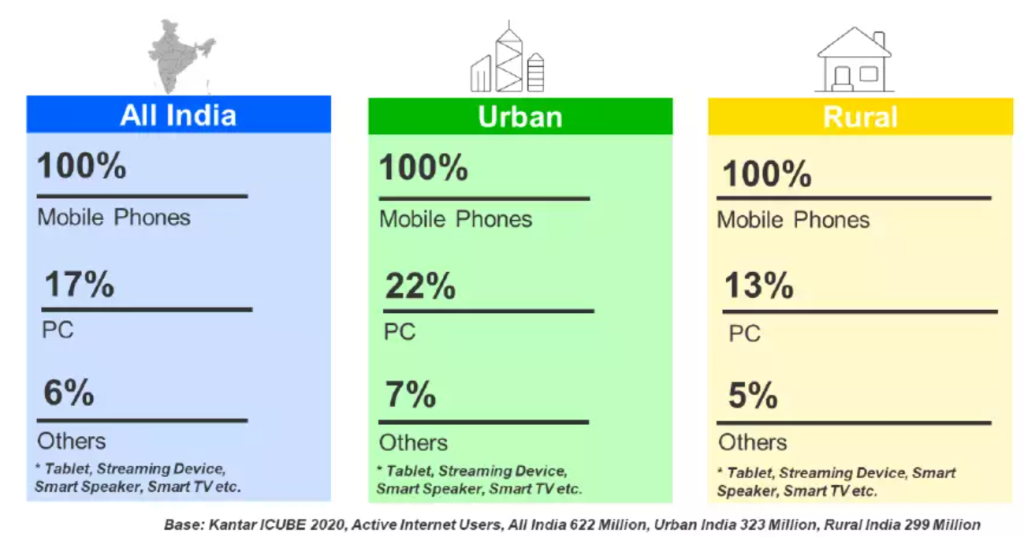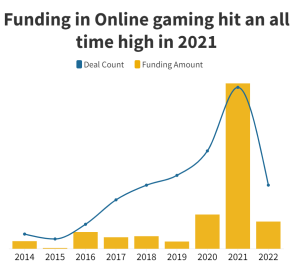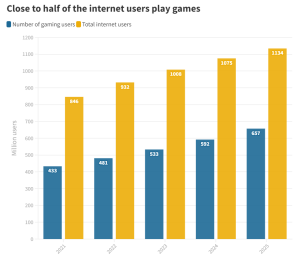CONTENTS
- Regulating India’s Online Gaming Industry
- India’s Online Gaming Industry:
Regulating India’s Online Gaming Industry
Context:
As we are aware, deficiencies in the market, such as monopolies, externalities, and information asymmetries, not only reduce economic value but also corrode societal well-being, leading to a decline in user trust. In such instances, government regulatory intervention becomes crucial. The effectiveness of this intervention depends on a straightforward criterion—the benefits of government involvement must outweigh its potential costs. These benefits include protecting public interest and trust.
Relevance:
GS-2
- Government Policies & Interventions
- Judgements & Cases
GS-3
IT and Computers
Mains Question:
The meteoric rise of online gaming has brought with it an array of concerns such as addiction, mental illness, suicides, financial frauds, privacy and data security concerns. Analyse. (15 Marks, 250 Words).
Digital Markets:
Internet Penetration in India:
- Digital markets have become integral to our daily lives, with India boasting the world’s second-largest internet user base of 692 million.
- Ranked eighth globally in mobile app usage time, with an average daily usage surge to 4.9 hours (a 32% increase since 2019), online services play a central role.
- Notably, 82% of this usage is dedicated to media and entertainment, with social media accounting for roughly half.
- IAMAI and market data analytics firm Kantar have jointly released the Internet India Report, providing insights into internet usage across the country.

Active Internet Users:
More than half of India’s population, equivalent to 759 million individuals, are active internet users, accessing the internet at least once a month. This active internet user base is projected to reach 900 million by 2025.
Rural and Urban Distribution:
Among the active internet users, 399 million reside in rural areas, while 360 million are from urban areas, indicating that rural India is the primary driver of internet growth. By 2025, 56% of all new internet users in India are expected to come from rural areas.
Regional Divide:
A significant digital divide exists due to variations in penetration rates, hindering internet growth in certain states. For instance, Bihar has 32% of users with less than half the internet penetration compared to the leading state, Goa, where 70% of the population uses the internet.
Gender-wise Growth:
Although 54% of internet users are male, 57% of all new users in 2022 were females. The projection for 2025 anticipates that 65% of new internet users will be women.
Popular Internet Services:
Digital entertainment, digital communications, and social media stand out as the most popular internet-based services in India. Social commerce has witnessed a notable 51% year-over-year growth, indicating an increasing reliance on social media.
Digital Payments:
Digital payments have experienced a 13% growth from 2021, reaching an estimated 338 million users, with 36% of these users residing in rural India
Concerns Associated:
- While this trend has brought significant benefits, it has also introduced new concerns, such as the proliferation of AI-generated deep fake videos of celebrities on the internet.
- These advanced simulations have blurred the boundaries between reality and fiction.
- Market failures in online services now exhibit new characteristics and complexities, primarily due to the intricate interplay of data and algorithms.
- The government is addressing these challenges by suggesting novel forms of digital regulation. In this context, online gaming emerges as a crucial sector where the manifestation of market failure is becoming apparent, yet there is a lack of sufficient regulation.
India’s Online Gaming Industry:
Various Categories of Online Gaming:
e-Sports:
- These are video games that were initially played privately or on consoles in video game stores during the 1990s.
- However, the current trend involves structured online play among professional players, either individually or in teams.
Fantasy Sports:
- In this genre, players assemble a team comprising real sports players from different teams.
- Points are earned based on the actual performance of these players in real-life sports events.
Online Casual Games:
- These games can be skill-based, where the outcome depends significantly on mental or physical abilities, or chance-based, where the result is influenced by random activities, such as rolling a die.
- If players wager money or items of monetary value, chance-based games may be considered a form of gambling.
Extent of the Online Gaming Market:
- The online gaming industry experienced substantial growth during the Covid-19 pandemic. Projections indicate that the revenue of the Indian mobile gaming sector will surpass $1.5 billion in 2022 and is anticipated to reach $5 billion by 2025.
- Notably, the industry in the country exhibited a Compound Annual Growth Rate (CAGR) of 38% between 2017 and 2020, surpassing the growth rates of 8% in China and 10% in the US.
- India’s percentage of new paying users (NPUs) in gaming has been the world’s fastest-growing for two consecutive years, reaching 40% in 2020 and further increasing to 50% in 2021.
- Projections suggest that AI and online gaming could contribute up to $300 billion to India’s GDP by 2026-27.


Concerns Associated:
- However, with significant advancements come inherent risks. Similar to other digital media forms, the rapid ascent of online gaming has raised various concerns, including addiction, mental health issues, suicides, financial fraud, as well as privacy and data security worries.
- Money laundering and national security considerations are also tangible realities. The situation is further complicated by the expansion of illicit offshore gambling and betting markets, where the substantial volume of digital transactions creates fertile ground for financial misconduct.
- In July 2023, the Parliamentary Standing Committee on Finance identified four prominent trends in cybercrime. Notably, one of these trends involves the utilization of international online betting sites for purposes such as money laundering.
- These issues signify a broader problem of market failure, primarily stemming from inadequate regulation.
- Take, for instance, the safety and financial implications of illicit offshore betting and gambling markets. The absence of a mechanism for individuals to distinguish between legitimate gaming platforms and illegal gambling/betting sites, coupled with the lack of a specialized regulatory authority, results in insufficient enforcement. Consequently, the number of illegal operators is increasing daily.
- The illegal offshore gambling and betting market receives $100 billion in deposits annually from India, with a growth rate of 20% over the past three years.
- Besides causing harm to users, the covert and untraceable operations of these platforms lead to substantial losses for the exchequer.
- Estimates suggest that India loses $45 billion in taxation annually due to the operations of illegal offshore markets.
The Global Perspective:
- From a global standpoint, the U.K. employs a centralized government regulator that regularly publishes the outcomes of regulatory measures in the sector to monitor their effectiveness.
- Recent reports indicate that, since 2017, operators violating player protection requirements have faced substantial multi-million-pound fines.
- The rigorous enforcement, along with targeted efforts for harm reduction from 2018 to 2022, has resulted in a decline in both disordered gaming and medium-to-low risk gaming behavior.
Way Forward:
- Addressing these challenges necessitates an urgent call for robust regulation in the online gaming industry.
- While some state governments attempt to ban online gaming, the inherent cross-border nature of the internet makes enforcing such bans almost impossible, resulting in the unintended consequence of legitimate, regulated platforms being replaced by unregulated and potentially harmful ones.
- In this context, the Information Technology (Intermediary Guidelines and Digital Media Ethics Code) Rules, 2021 represented a commendable step toward oversight.
- However, the delayed notification of Self-Regulatory Bodies has impeded progress. To safeguard the 373 million gamers in India, who are potentially at risk, it is crucial that the sector undergoes strict regulation.
Conclusion:
An unregulated market may not contribute maximally to the overall welfare of society. According to the International Monetary Fund, a combination of high taxes and a lax, discretionary approach to regulatory enforcement creates an ideal environment for the emergence of a shadow economy—an environment resembling that in which the Indian online gaming industry operates. Therefore, the establishment of a stringent regulatory framework is an urgent necessity, not only for safeguarding our digital citizens and national interests but also for ensuring the responsible growth of the online gaming sector.
Swami Vivekananda: The Ultimate Youth Icon
Context:
National Youth Day, also recognized as Vivekananda Jayanti, is observed on 12 January, marking the birth anniversary of the Hindu monk Swami Vivekananda. The Government of India officially designated this day as National Youth Day in 1984, and the celebration has been an annual event in India since 1985. The theme for this year’s festival is “Viksit Bharat@ 2047: Yuva ke liye, yuva ke dwara.”
Relevance:
GS4- Ethics
- Lessons from the Lives and Teachings of Great Leaders
- Contributions of Moral Thinkers and Philosophers from India and World
Mains Question:
In the context National Youth Day, 2023, discuss the beliefs of Swami Vivekananda and his contributions towards the development of ethics in India and the world. (10 Marks, 150 Words).
Early Life of Swami Vivekananda:
- Swami Vivekananda, the fearless evangelist, who was born as Narendranath in Calcutta (now Kolkata) on January 12, 1863, and lived only 39 years.
- His transformation into a dynamic and resplendent personality was a result of unwavering devotion to his Guru, Sri Ramakrishna Paramahamsa.
- Swami Vivekananda’s vibrant persona symbolized the socio-political-cultural-religious renaissance in 19th-century India.
- His early struggles in job searches, marked by failures, made him skeptical and disdainful of the daily grind.
- The visionary saint, Ramakrishna Paramahamsa, and his devoted disciple were united by a cardinal principle – service or seva to mankind.
Beliefs of Swami Vivekananda:
- Swami Vivekananda, akin to Buddha, demonstrated a profound understanding of the human mind, addressing its complexities with a less visceral approach.
- His boundless energy and dynamism left little time for rest, as he ignited the imagination of the public, especially the youth.
- Influenced by characters from Hindu mythology like Sita, Savitri, and Damayanti, Swami Vivekananda admired their contributions to Indian womanhood, embodying Universal Motherhood.
- An unwavering seva warrior well-versed in Vedanta, Swami Vivekananda encouraged monks to swap the Bhagavad Gita for football, emphasizing the need for robust minds and bodies.
- Proficient in political ideologies such as socialism, anarchism, and nihilism, he played a role in shaping the Congress youth during the Swadeshi movement.
- Jawaharlal Nehru acknowledged Swami’s impact on the evolving political landscape, drawing parallels between Vivekananda’s socialism and traditional Vedanta.
- At the forefront of the country’s cultural and spiritual renaissance, Swami Vivekananda’s mind was troubled by prevailing poverty, the caste system, and societal norms.
- He envisioned a contemporary India rising from the dwellings of the impoverished peasantry, cobblers, fishermen, and other marginalized sections.
- A striking feature of his personality was his pristine humility, making him accessible to all. He never sought to appropriate the movement, firmly believing that after him, many more Vivekanandas would emerge to serve the motherland, each surpassing him.
- Swami Vivekananda introduced Indian philosophies of Vedanta and Yoga to the Western world, playing a crucial role in raising interfaith awareness and bringing Hinduism to global prominence during the late 19th century.
Vedanta:
- Rooted in the Upanishads and their interpretation.
- Focused on the inquiry into ‘Brahman’ (ultimate reality), central to Upanishads.
- Regarded the Veda as an unquestionable source of information.
- Emphasized the path of knowledge (jnana) over sacrifice (karma).
- Ultimate goal of knowledge was ‘Moksha,’ liberation from ‘samsara.’
Contributions of Swami Vivekananda:
- Established the Ramakrishna Mission in 1897, dedicated to extensive educational and philanthropic work in India.
- Represented India at the first Parliament of Religion in Chicago in 1893.
Core Values of Swami Vivekananda’s Philosophy:
Ethics:
- Introduced a new theory of ethics based on the intrinsic purity and oneness of the Atman.
- Ethics viewed as a code of conduct fostering good citizenship.
- Emphasized purity as the inherent nature of individuals.
- Advocated love and service for neighbors as a reflection of unity in the Supreme Spirit (Paramatma or Brahman).
Religion:
- Interpreted religion as a universal experience of transcendent Reality, common to all humanity.
- Liberated religion from superstitions, dogmatism, priestcraft, and intolerance.
- Believed every religion provided a path to the eternal supreme, achievable by realizing one’s Atma as part of Paramatma.
Education:
- Emphasized education for the regeneration of the nation.
- Considered a nation advanced in proportion to the spread of education among the masses.
- Advocated character-building and man-making education.
- Stressed the importance of self-reliance and facing life’s challenges through education.
Rationality:
- Embraced the methods and results of modern science.
- Recognized intuition as a higher faculty than reason but insisted on explaining and systematizing truths derived from intuition.
Nationalism:
- Rooted nationalism in Indian spirituality and morality.
- Based on Humanism and Universalism.
- Focused on freedom, equality, and spiritual integration through universal brotherhood.
- Established motherland as the primary deity in the minds and hearts of the countrymen.
Youth:
- Believed in the potential of determined youth to achieve the impossible.
- Urged dedication to a cause for success and emphasized pursuing challenges with utmost dedication.
- Advocated the development of both mental and physical strengths.
Conclusion:
Even though Swami Vivekananda lived in the 19th century, his message and life resonate more strongly in the present and are likely to remain highly relevant in the future. Individuals like Swami Vivekananda, despite their physical departure, continue to leave a lasting impact. Their influence, thoughts, and the initiatives they undertake gather momentum over the years, eventually achieving the fulfillment they envisioned.




